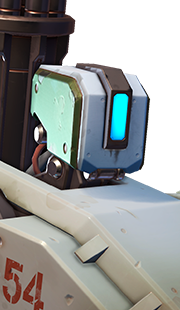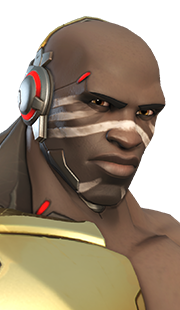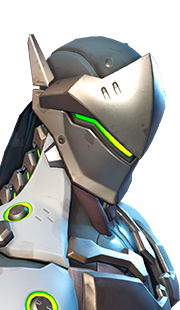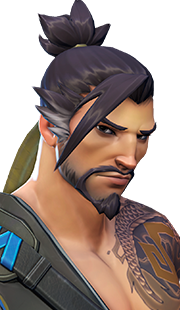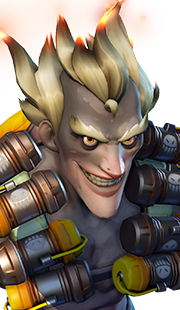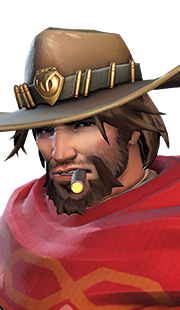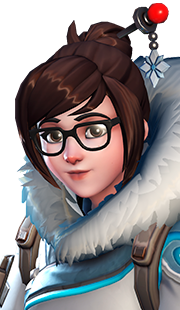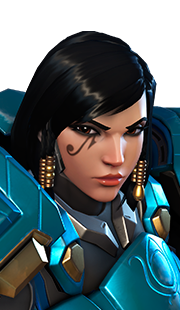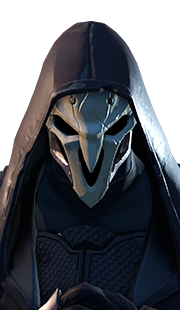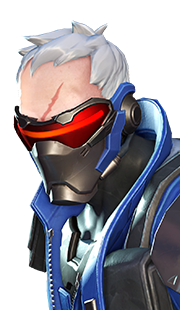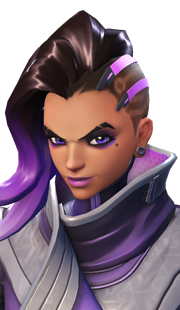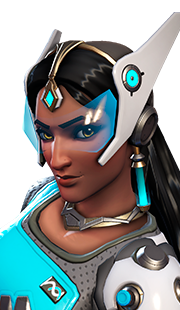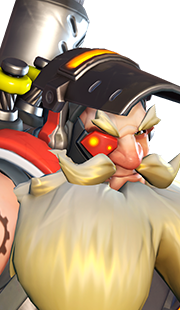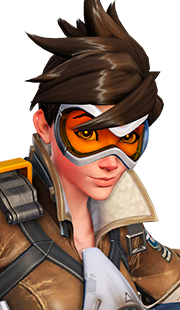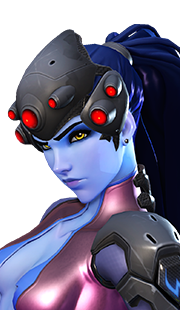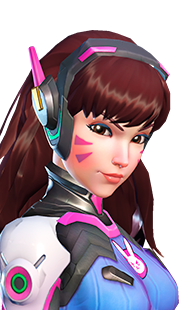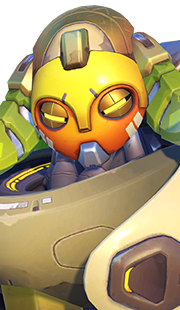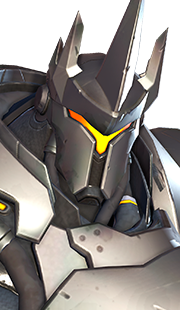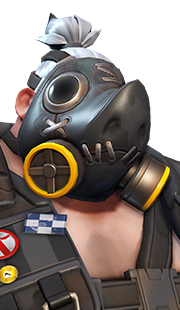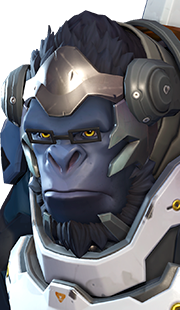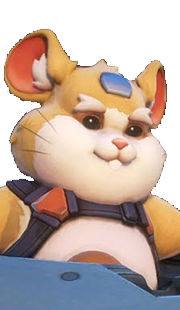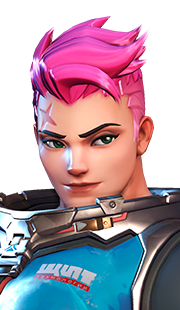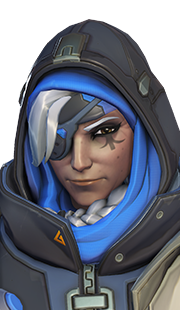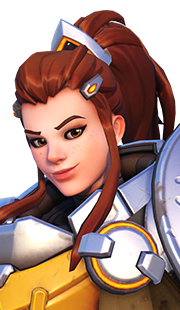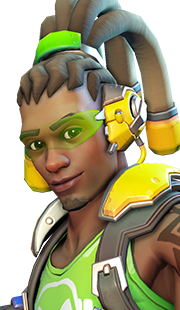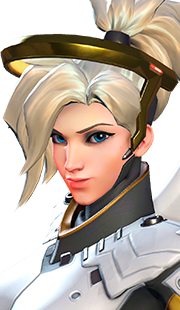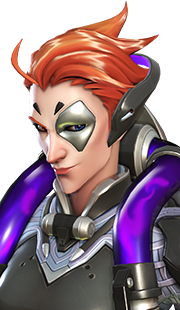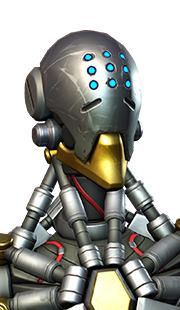Glossary of Terms
Table of Contents
1.
Foreword
On this page, we are maintaining a list of all the Overwatch terminology that we use in our guides, which we consider requires additional explanation. In some cases, the terms may be totally unknown to some of our readers, while in other cases they may have a different meaning than their wording may imply.
2.
Glossary
| Terms | Explanations |
|---|---|
| Ability | One of the unique moves that a hero can utilize in a game of Overwatch. |
| Ability Chain | When a player uses two or more of a hero's unique abilities in a synchronized fashion for maximum output. |
| Advantage | When one team has more players alive than the other team. |
| Analyst | A person who analyzes Overwatch League team play after a map or match has ended. |
| Arcade Modes | Modes of Overwatch that can be found under the Arcade tab. These modes are nontraditional game types (1v1,3v3, Capture the Flag) that Blizzard developers create for players to enjoy. Every week, a player can gain 3 lootboxes by winning 9 arcade mode games. |
| Area of Effect | When a hero's ability affects a specific area instead of affecting a specific hero. An AoE will effect team members and/or enemies within the ability's radius. Each AoE ability has its own radius of effect (4m, 10m, etc.) its own duration time (1s, 7s, unlimited) and its own effect type (heal/shield/speed/allies; damage/slow/stun/enemies). |
| Armor | A type of health in Overwatch, armor is like health points, except it is more damage resistant. For every projectile that deals at least 10 damage, the armor will reduce that damage by 5. So, if an ability deals 15 damage, it will only deal 10 damage to armor. For every projectile that deals less than 10 damage, that damage will be halved by armor. So, if a projectile deals 6 damage normally, it will only deal 3 damage to armor. This means that armor is more resistant to weapons that use more projectiles with smaller damage outputs (shotguns, machine guns) when compared to weapons that use a small number of projectiles that deal more damage (snipers, explosive-based weapons). For example, if a sniper shot deals 200 damage, armor blocks 5, for a total of 195 damage received. However, if a machine gun deals 10 damage per shot, and armor is hit 20 times, it will result in 100 damage received. |
| Assault Maps | A type of game mode in Overwatch. Assault maps require that one attacking team captures two sequential points, while the defending team try to defend those points. Both teams have a chance at assault and defense in competitive play, and the match can end in a draw if both teams have the same number of objective captures when their attack time runs outs. |
| Attack | When a team is on the offensive and trying to capture objectives to win the round. When a team is on attack, they will attempt to get past the defense and accomplish one of the following objectives: capture two points (assault maps), push a payload across the map to its destination (escort maps), or capture a point and then push a payload across the map to its destination (hybrid maps). While a team can fail to accomplish all of their objectives within their given attack time, the progress they make is saved and counted towards their overall score. Whichever team is able to make the most porgress on attack within their attack timer will win the map. Therefore, the attacking completing all the objectives within the attack time is not required to win a map. |
| Attack Timer | In quick play games, the attack timer is the amount of time the attacking team has to fully secure the objectives before they lose the round. In competitive and professional play, the attack timer is a team's allotted time to capture as many objectives as they can. Whichever team can capture more objectives with their allotted attack time will win competitive or professional matches. The attack timer increases for an attacking team if they take checkpoints in escort maps, or point A in assault maps. When the attack timer hits 0 for an attacking team, unless the attacking team is currently on the objective, the round is over. If the attack timer hits 0 for an attacking team and attacking team members are on the objective, the game goes into overtime. |
| Back Out | The goal of backing out is taking a lost fight and regrouping to try again. When an Overwatch team loses a couple of allies in a fight, the other members of the team will back out of the fight and wait until their team members respawn. |
| Backline | Heroes that sit behind ally tank heroes and work best without taking on enemies face to face. |
| Bait Players | When a player is wounded and purposefully runs away from an enemy, making the enemy give chase. The enemy is then out of position from the rest of his team and is killed for trying to chase the kill. |
| Bait Ultimates | When a team or player purposefully goads an enemy(ies) into using their ultimate(s) at an nonstrategic time in the match. |
| Barrier | A form of protection for a team, created by one of its members. "Barriers" are always faint blue in color, and translucent to both enemies and allies. "Barriers" do not affect ally shots or damage-dealing abilities, but do block enemy damage from coming through (although enemies can walk through barriers). All "barriers" have a certain amount of health, and can be destroyed by enemies. However, some "barriers" can last indefinitely if not harmed, and other "barriers" only last for a specified amount of time. Abilities that pass through enemy barriers include: Moira's Coalescence, Winston's Tesla Cannon, Reinhardt's Fire Strike, Ana's Nano Boost, Mei's Blizzard (just the drone, not the freeze ability), Hanzo's Dragonstrike, and Symmetra's secondary fire of photon projector. Reinhardt's Barrier Field, Winston's Barrier Projector, Symmetra's Photon Barrier, Orisa's Protective Barrier, and Zarya's Particle Barrier and Projected Barrier are the only "barriers" currently in the game. It should be noted that Zarya's "barriers" are able to block all damage sources. |
| Buff | A type of utility ability that assists teammates. Buffs can help teammates gain speed, deal more damage, and gain more hit points, among other bonuses. A player can lose their buff in a number of ways like it running out of time, it being transferred to other allies by the creator of the buff, or by losing it due to enemy actions. |
| Burst Damage | An ability or chain of abilities that can deal huge amounts of damage on an enemy very quickly. |
| Burst Fire | When a player shoots a fully automatic weapon in short bursts to keep their aim focused on a specific target. Burst fire allows a player to shoot with better accuracy while sacrificing the amount of bullets he or she shoots overall. The idea behind burst firing is that it is better to hit a few shots than miss all of them. |
| Bursted | When a player is killed very quickly, usually before they have time to react to the damage. |
| Carrying | When one member of the team is playing really well and is carrying the team to victory. When this is said, it can have the implication that the other team members are not doing well. |
| Caught Out | When a player makes a mistake and ends up dying due to their poor positioning. The player who dies is either caught out in a spot on the map where they should not be, or they are caught out because they are away from their team when they should not be. |
| Channel Abilities | Abilities that can take a few seconds to charge, forcing the player to wait to use the ability or wait for the ability to have its maximum effect. McCree's Deadeye ultimate and Doomfist's Rocket Punch are both abilities that a player can channel for maximum impact, while Mercy's Resurrect is an ability that must channel before being used. |
| Charge Abilities | Abilities that store a number of uses, and go on cooldown once a charge is used. Some abilities, like Junkrat's Concussion Mine, start to regenerate a charge once that charge is used. However, other charges can still be used while the first charge regenerates. Non-regenerative charge abilities, like Symmetra's Teleporter, do not regenerate when used. |
| Checkpoint | Overwatch is a game that requires teams to capture or defend positions. However, the game is developed in such a way that players can make progress towards capturing these objectives. When a team captures a portion of an objective or map, it is called a checkpoint. |
| Choke Point | A choke point is a map feature that funnels an attacking team into one or two narrow pathways. This makes it easy for the defense to slow down the attacking team since the defending team knows exactly where the attackers are coming from. In other words, the attacking team is assured to come from this small opening, but the passage's size will slow down the attackers advance, thus choking their forward movement. |
| Commit | When a team or player performs an action and sticks to that action regardless of the consequences. Committing can be used positively or negatively depending on the outcome of the committed action. For example, a team may commit to a player who plays Widowmaker. This means the whole team trusts that the player can utilize Widowmaker well, and the team will commit to the player's Widowmaker by choosing heroes that have synergy with a Widowmaker. If the Widowmaker plays expertly, than the commitment to the Widowmaker will pay off. In other situations, players can over-commit, where a player or team will commit to a plan that ends up backfiring or failing continuously. Over-commitment often occurs when a player tries to secure a kill and goes too deep into enemy territory, or when a team commits to a specific team composition that is not effective against their opponent. Additionally, a team may under-commit to team fights. This means that a team is over thinking the game and is being slow in their team play. Rather than attack their enemy with confidence, they are waiting around and not committing to team fights. This means the team is playing scared, and are afraid to commit to any action. |
| Contest | When a team is trying to take an objective, the defensive team can stand on the objective and contest attackers from taking the objective. This means attackers can only progress objectives when there are no opposing players in the area. So contesting is when the defense is stopping the offense from progressing the objective. |
| Control Maps | Maps where both teams try to secure the same objective at the same time. In control map play, teams must fight for control of a central objective. Once a team secures the objective, they will fill a meter based on how long they can hold the objective from the enemy. However, the other team can take the point and begin to fill a meter of their own. Whichever team can be the first to fill their meter to 100% and have the point uncontested by enemies wins the round. Control maps are best of three rounds. |
| Cooldown | When a hero uses special abilities, they will be unusable again for some time. While it can not be used, it is considered to be on cooldown. Cooldowns are typically time-based, with each ability having its own cooldown time. Cooldowns vary for different abilities and different heroes. |
| Countered | When a player's action is canceled out by an enemy's action. Typically a counter is an action that directly opposes another player's action. For example, if player A tries to use an ability to kill enemy B, then enemy C uses an ability to save enemy B, then enemy C's action countered enemy A's action. |
| Create Space | When a player forces enemies to move away from an objective or team fight. Creating space allows a team to regroup, heal up, or escape from an immediate threat. |
| Credits | Overwatch currency that can be used to purchase in-game items. Credits are gained from obtaining duplicate items, or by opening credits in loot boxes. |
| Crowd Control | Crowd control abilities are abilities that impede an enemy's movement in some way. There are various types of crowd control, such as slows, stuns, displacements, traps, and others. Essentially, a crowd control ability is any ability that disallows enemies from having normal movement functions. |
| Damage Per Second | DPS is a calculation of a hero's damage potential output in one second of time. Every hero has different DPS values that interplay with their main abilities and class type. |
| Debuff | An ability that negatively affects enemies. Debuffs are usually time sensitive, and can affect an enemy's movement, hit points, or abilities. |
| Deep | When a player has gone too far into enemy territory, usually resulting in the death of the player. Going too deep is often attributed to players who are impatient or who are not playing with their team. Going deep is rarely a good idea without solid backup from teammates. |
| Defense | When an Overwatch team's main goal is to stop the attacking team from capturing objectives. When playing defense, the team cannot obtain points, they can only stop the attackers from gaining points. |
| Defensive Heroes | Defensive heroes in Overwatch are heroes whose main abilities are tailored to stop enemies from advancing on an objective. Defensive heroes thrive on chokepoints and utilize lots of crowd control abilities, or deal heavy damage outputs from afar. |
| Deny a Kill | Denying a kill is when a player or player's ally stops the enemy from securing a kill. The phrase is used when a player is saved by their own actions or the actions of their teammates. |
| Deny a Play | Similar to countering, denying a play is when a player stops an enemy team or team member from performing an action that would result in a lost team fight or game for his or her own team. Announcers will use deny as a verb to say that an action got countered. |
| Direct Hit | When a DPS projectile hits an enemy directly, resulting in higher damage outputs when compared to projectile splash damage. |
| Disengage | To discontinue attacking or chasing the enemy team, allowing you to regroup with your team to plan another attack. Teams can disengage from teamfights, and individuals can disengage from a duel. |
| Disrespect | When a player performs an action that challenges the intelligence or skill of an enemy player. Disrespects often come in two forms. A player may disrespect another player by utilizing their hero in a way that is out of the ordinary (if a support takes on an assailant and kills them). A disrespect may also come in the form of using in-game actions to mock an opponent (shooting enemies bodies after their death, or using in-game sprays after executing a good play, which is a sign of self-acknowledgment, i.e, showing off). |
| Dive | A team composition that utilizes highly mobile heroes that can jump onto single targets and overwhelm enemy teams. Teamwork is required to efficiently utilize dive compositions, as the team must dive in as a unit for the strategy to work. |
| DPS | A DPS hero is any character in Overwatch whose main purpose is to deal damage to enemy heroes. |
| Draw | When a map ends with both teams capturing the same amount of objectives. Draws do not change a player's SR, and draws in Overwatch League result in both teams obtaining a map point. Draws can only occur on hybrid and assault maps. |
| duel | When two players on opposing teams fight each other with no help from allies. Duels are typically hard-fought and an exciting part of Overwatch play. |
| Duelist | A hero that can take on another hero one on one. A duelist is not guaranteed to kill another hero one on one, but their kit gives them a pretty good chance. |
| Engage | To encounter and attack the enemy team. Engagements are literally fights, and each engagement will end with one team coming out ahead, or both teams backing off from the fight until one team engages again. Typically, the team on offense will be the one to start engagements. |
| Escort Maps | A game type in Overwatch where the attacking team must push a payload along a set route while the defending team tries to stop the advance. Escort maps require that the attacking team escort the payload through various checkpoints and ultimately to the payload delivery point. In competitive play, whichever team pushes the payload furthest wins the round. |
| Farm | When a player charges their ultimately quickly by utilizing another player. Ally healers farm ultimate by healing their own players. Ally DPS farm ultimate off of enemy players by dealing damage. |
| Fill | When a player is willing to pick their hero last, allowing other players to play their preferred roles. The fill player forgoes their ability to choose their role for the sake of helping their team make the best composition by filling whatever role (tank, DPS, healer) is needed. Filling is beneficial for a team, as it allows other players to choose their roles, making them happier with the atmosphere of the current match, and giving them the chance to play their best roles. However, fillers or someone who fills for a team, runs the risk of playing one of their worst roles in order to help the team composition. For this reason, fillers should be comfortable with heroes in every role category. |
| Finish | To kill an enemy who was at low health. The term finish usually means that one player got an enemy low, and an ally finished the kill. |
| First Person Shooter | A video game where players see from the eyes of their character. The way the player experiences the game is directly tied to how the player's character sees the world from their perspective. This is the meaning of first person. Shooter refers to a game that is predominately about shooting enemies and dodging bullets. Therefore, Overwatch is a game in the FPS genre. |
| Flank | When a player utilizes a portion of the map that allows them to circumvent the enemy team, allowing the player to engage opponents from behind. The flanker's team will usually engage the enemy from the front, allowing the flanker to deal the most damage to the enemy backline while forcing the enemy to deal with threats from two different angels. |
| Flanker | A hero whose primary kit allows them to get behind enemy lines and attack the opposition from a different angle. A flanker's primary goal is to distract enemy players and kill opponents that are split from their team. Flankers typically want to stay alive for as long as possible while dealing a good amount of damage. Flankers are a nuisance to support heroes, and if left to fend for themselves, flankers will typically kill support heroes who are not paying attention. |
| Flick | When a player secures a kill by flicking their wrist. A flick usually occurs when a player sees someone on the edge of their screen and flicks their wrist to bring their weapon reticle onto the opposing player's body. A flick takes a considerable amount of precision in both timing and accuracy. Flicks are usually performed with heroes like: Hanzo, Widowmaker, McCree, and Soldier: 76. |
| Focus | When a team wants to put all their efforts into accomplishing one task. Typically, when a team focuses, they plan to kill a specific enemy first, and all team members go after that enemy before doing anything else. |
| Follow Up | When a team or player capitalizes on a teammate's performance, usually resulting in the securing of a kill or team fight. Following up is a show of synergy between a team or specific players. |
| Force | When a player is aggressive and forces an enemy to move away from a team fight, objective, or high ground area. The player may not kill the person he forces out or off of something, but his presence is enough to force the enemy back. |
| Frag | To kill an enemy. |
| Fragging Out | To kill a lot of enemies, usually in a stylistic or impressive manner. |
| Frontline | The tanks and other heroes in the game that are supposed to take the brunt of the damage from the enemy team. The frontline is the group that that usually engages the enemy team first, with the back line following the frontline into the fight. |
| Full Hold | When the defensive team stops the attacking team from securing any portion of an objective. On payload maps, a full hold is when the defensive team stops the attackers from capturing a checkpoint. On point maps, a full hold is when the defensive team does not allow the offensive team to get a tick on the first point. |
| Gap-Closer | An ability that quickly takes a player towards an enemy. Gap-closing abilities are heavily utilized by dive compositions made up of Winston, Tracer, D.Va, and other heroes. |
| Get a Hero | When a team or player believes that an ally needs to switch to a new hero. When a player needs to get a hero, it is usually because the current team composition is not working, and the players want to switch around the makeup of the team. A team may also need to get a hero to counter a specific enemy hero that is playing really well. For example, if the enemy Widowmaker is killing a team, the team may suggest that one of it is players gets a Winston. Getting a hero is not guaranteed to make the team perform better, but it may help the team play better against their opponent. |
| Get an Enemy | To plan to focus on a specific enemy to open the team fight. A team will usually want to get an enemy when that enemy is playing particularly well, or that enemy hero is crucial to the enemy teams' victory. |
| Give | When a defending team has lost members to the attacking team, the rest of the defending team members may choose to give the objective. Giving the objective is similar to the idea of lose the battle, win the war. Rather than throw themselves to a sure loss on the point, the defending team members still alive back out from the fight and give the point. This allows the defending team to regroup without giving the attacking team more kills and confidence. It should be noted that defending teams will never give the last objective on a map because that is losing the war. So giving an objective only happens on earlier map points. |
| Grandmaster | The second highest rank (behind Top 500) a player can achieve in competitive Overwatch. Grandmaster is above a 4000 SR rank. These rankings have nothing to do with professional Overwatch play, but are used to rank players who play competitively online. |
| Harass | When a hero can suppress an enemy from effectively helping their team by being a nuisance. Players can harass an enemy from afar using Widowmaker, McCree, or Soldier: 76; or can harass a player up close using Genji, Tracer, or Winston. |
| Headshot | When a player shoots another player in the head. Some hero attacks will deal twice the normal amount of damage when they shoot a player in the head. This means a bullet that typically deals 20 damage will do 40 damage when the bullet hits an opponent's head. Widowmaker's Widow's Kiss: Sniper deals 2.5 times the damage when she scores a headshot. This means a bullet that deals 20 damage will deal 50 damage when a Widow's Kiss: Sniper shot hits a player in the head. |
| Heal | When a player regains health points after they were hurt by an enemy. |
| Healer | A hero whose main kit allows them to restore health to their allies. A healer's main goal is to keep allies alive as they fight enemy heroes. |
| Health Packs | Health packs are healing items that are found in specific areas of Overwatch maps. Health pack locations are locked on a map, meaning health pack locations are always the same for each specific map. A player must run over a health pack to restore health to their hero. The health pack is then put on cooldown for 10 or 15 seconds, depending on the size of the health pack. The pack respawns once the cooldown is over, then another player can capture the pack, and the cycle continues. Small health packs restore 75 hit points and big health packs restore 250 hit points. |
| High Ground | A place on a map where the player has a height advantage compared to the typical playing field. High ground is used to kill enemies from far away. High ground is seen as advantageous because it is typically easier for a player to shoot down on enemies than it is for a player to shoot up at enemies. |
| Hit Points | The health system in Overwatch. A hero's hit points consists of the combination of their total health, armor, and shields. When a hero reaches zero hit points, they are killed, and must wait to respawn to get back in the game. |
| Hitbox | The outline of an Overwatch hero that registers if a shot lands and if a hero should take damage. Hitboxes are all relative to the size of the hero, with Ana, Mercy, and Genji having some of the smallest hitboxes, and Roadhog, Reinhardt, and Winston with some of the largest. |
| Hitscan DPS | A hero whose damage is accounted for through hitscan registry. Hitscan registry is based on a player's ability to aim and shoot a target. Hitscan heroes do not create projectiles from their weapons, and a shot either hits or misses a target based on the reticle of the player being on the target when the mouse button is pressed. If the reticle is on the target when shots are fired, the target will take damage. If the reticle is not on the enemy, the enemy will not take damage. |
| Hold | When the defensive team stops the attacking team from securing a specific objective. The attacking team may have secured point A, but the defensive team can still hold point B from the attackers. |
| Hybrid Maps | Maps that are a mixture of escort and assault game types. One attacking team will try to capture a point (like assault). If they succeed, they will then try to deliver a payload (like escort). When playing competitive, the defense will have the opportunity to try and best the other team's push. Whoever can get the furthest through the map wins. |
| Initiate | When a player starts a team fight by shooting the first bullet. Essentially, initiation is the first act of aggression by one of the players on a team, which usually leads into a team fight. The front line is typically the initiator of a fight. |
| Interrupt | To stop an enemy from performing an ability by using a crowd control ability. Interrupting an ability forces the enemy's interrupted ability to go on cool down. McCree's Flashbang is an ability that can interrupt many enemy abilities, and sometimes even enemy ultimates. |
| Jump | When a player or team tries to quickly kill an enemy before their opponent can respond to the action. |
| Kit | The specific abilities that each hero has available for a player to utilize. Every hero has a different kit in Overwatch that helps the team in a specific way. |
| Line of Sight | The vision that a hero has directly in front of their field of view. If an ally is in front of the player, but the ally is behind a wall, the ally is not in line of sight of the player. Therefore, line of sight is based on vision, not on proximity. An enemy across the map can still be in the line of sight of a sniper, despite the distance. Many hero abilities work in tandem with line of sight. For example, Mercy can only heal allies that are in her LOS and in range of her Caduceus Staff. |
| Lineup | A lineup is the actual players of the game, not the heroes in the game. So a lineup is the composition of players on a specific team. |
| Looks | When an announcer is unsure of the outcome of a situation during professional play, they will start their statement with looks. Looks is used when the announcer wants to weigh in on the situation, but is not sure that the situation is going to play out the way they said it might. |
| Loot Boxes | Boxes that contain in-game items that change a hero's style and emotes. Loot boxes also contain player items like player icons and sprays that can be used in game. Loot boxes can be purchased with real money, or earned by various in-game methods. |
| Low | When a player's hero is close to death. |
| Main | A main is a player's preferred hero or category of heroes that they want to play. For example, some players main specific heroes like Winston, McCree, or others. Other players main specific roles such as DPS, support, or tank. |
| Main Support | A hero whose kit primarily focuses on restoring other heroes health. Typically, a main support will focus solely on healing teammates and very rarely try to deal damage to enemies. |
| Main Tank | A main tank hero in Overwatch has a kit the mostly protects his team from damage. A main tank can get kills and deal damage, but is called upon to protect his team. |
| Make a Play | When a player is able to successfully outperform his opponent(s) and either take an objective or kill an enemy. The term can also be used by announcers to suggest that a team member or team need to make a play due to the attack timer running out. |
| Map | In all game modes of Overwatch play, every game takes place on one map. The game begins on a randomized map, and the game is over when one team is proven victorious over the other team on that map. Therefore, online Overwatch games happen one map at a time. |
| Map Awareness | A player's ability to understand what is happening around them in the heat of battle. Map awareness is a highly important skill in Overwatch, since understanding the flow of a team fight can lead to a player's ability to correctly react to specific circumstances. |
| Map in Overwatch League | In Overwatch League, a map is only a portion of a full match. Overwatch League teams will play a guaranteed four maps in a match, unless the four maps end in a tie. If a tie occurs, the match will extend to a fifth map. The main difference between a map during Overwatch League when compared to online Overwatch play is that the match extends over numerous maps instead of the outcome being decided by one singular map. |
| Match-Competitive | A game type in Overwatch, a competitive match is a nonprofessional Overwatch match between online players. A competitive match counts toward the skill rating (SR) of a player, and their skill rating will place them in Bronze, Silver, Gold, Platinum, Diamond, Master, Grandmaster, or Top 500. These placements can be compared to online leader boards that show the relative skill of a player when compared to the rest of the server's players.Competitive Overwatch games are longer than quick play games, and players stake their SR to gain more SR points. |
| Match-Overwatch League | A match in Overwatch League is a series of games between two regional Overwatch League teams. These teams go head to head in a match, and will play best of four maps, with a fifth map introduced if the first four maps end in a tie. The winner of a match will gain a point that places the team for postseason Overwatch League play. |
| Mechanic | An aspect of a game that can be practiced and mastered by a player. Ultimate and ability usage, aim, positioning, and other aspects of Overwatch are all in-game mechanics that players must practice to become better at the game. Typically, when a player has excellent mechanics, it means they are a master at utilizing the real world tools (mouse, keyboard, controller) that move their character around the game. Therefore, mechanics can be used to talk about a player's ability to expertly move their character, and in-game mechanics can be used to describe hero abilities and other parts of Overwatch gameplay. |
| Melee | An ability that all heroes can use, melee will deal 30 damage to an opponent who is right next to a player, and takes half a second to execute. Once a melee is used, a hero cannot use it again until a full second has passed. A melee is typically utilized when a player has run out of ammo or wants to finish an enemy with a combo. |
| Melee Abilities | Melee abilities are any abilities that use melee mechanics. Melee abilities will only deal damage when a player is right next to an enemy. Melee abilities include Genji's Dragonblade, Reinhardt's Rocket Hammer, Torbjorn's Forge Hammer, and Winston's Primal Rage. |
| Melt | When a player kills an enemy hero very quickly. Melt is usually used when a player takes the enemy from full health to death in a couple of seconds. |
| Miscommunication | When a team of Overwatch players fails to communicate to each other correctly, usually resulting in a team kill for the enemy team. |
| Mobility | An Overwatch hero's capability to quickly move from one location to another. Some heroes have very low mobility: Roadhog, Zarya, Zenyatta. Other heroes have very high mobility: Genji, Tracer, Winston, Lucio. Mobility is a main component of team composition decisions in standard and professional Overwatch play. |
| Multi-Target Abilities | An ability that can help or harm multiple players. Area of effect abilities can be multi-target abilities. |
| Nullify | To cause an enemy player's actions to be stopped or countered. |
| Number for Number | When announcers comment on Overwatch play, they typically use numbers to specify how many people are killed on each team during a team fight. For example, if one team suffers two deaths, and the opposing team suffers one death, that would be considered a 2 for 1 trade. A number for number comment is made only when a team fight has stopped for second or when analysts are reviewing professional play. In-game players may use a number for number comment when they are quickly assessing what to do next. For example, a team may be trying to decide if they should attack a point. Although one of their members recently died and is not with the team, the enemy team has two dead, which is a 2 for 1 trade. |
| Objective | The main focus of Overwatch games. For the attackers, completing the objective(s) means victory, for the defenders, stopping the attackers from accomplishing the objective(s) means victory. There are two types of objectives, Payloads and Capture Points. You can read more about them under their definitions. |
| Off Support | A hero whose kit helps allies stay alive, but also focuses on dealing damage to enemies. Both Zenyatta and Moria have kits that would fit under the category of off support. |
| Off Tank | An Overwatch hero that fits into the tank role, but whose kit and play style is not made to mostly protect other players. These tanks can protect ally players, but its usually in an offensive manner and their protection is not as potent as main tank defenses. The list of off tanks from least like a main tank to most like a main tank are, Roadhog, Zarya, D.Va, and Winston(can be main tank if running dive composition). |
| Offensive Heroes | Offensive heroes in Overwatch are heroes that have high mobility and whose main goal is to deal DPS to enemies. The idea behind offensive heroes is that they are damage dealers who can be utilized to attack and take objectives. |
| One-Trick | When a player only plays one hero at their current level of skill. One-tricks are widely criticized by other players for their inability or unwillingness to pick team compositions for their teammates. One-tricks are often loved or hated based on the hero that they one-trick on. |
| Open | When a player gets a pick to start a fight. If an ally opens a fight, it means they have given their team a player advantage by killing an enemy. |
| Out of Position | When a player is not where they should be, usually away from their teammates and alone, typically resulting in the death of the out of position player. |
| Overtime | Overtime is the extra time an attacking team has to capture a point after their attack timer runs to 0. Overtime is only triggered if an attacking team member is on the point when the attack timer runs out. Overtime forces the game to go into a sudden death type of scenario for the attacking team, where attackers must be standing near or on the objective to continue trying to capture a point. If the attackers step off of the objective for too long, the round will end without them capturing the point. Overtime team fights are often the deciding factor between a team winning or losing, so Overwatch overtime play is very exciting to see. |
| Passive | An ability that does not need to be turned on, but automatically occurs as a result of various circumstances. Some passive abilities are always on, such as Sombra's Opportunist. Some passive abilities occur with time delays and under specific circumstances, like Mercy's Regeneration. Some passives, like Brigitte's Inspire, can have hidden cooldowns or other limiting factors. Passives can heal allies, damage enemies, or have beneficial utility effects that help the player win the game. |
| Payload | An objective that the attacking team must secure at the defending team's base by personally escorting it across the map. A payload is a movable objective that gains ground when the attacking team is within close proximity. The payload travels along a set route on payload specific maps, and travels at varying speeds depending on the amount of attacking players nearby. The payload stops moving when no attacking players are nearby, or when defending players are contesting the payload by standing in close proximity. |
| Peek | When a player looks around a corner at an enemy player, typically with the intent to kill the enemy from a distance. Peeking is generally associated with long range DPS characters like Widowmaker, Hanzo, McCree, and others. |
| Peel | When ally players help a backline player who is being attacked by an enemy. Peeling is creating space, but specifically creating space between an ally who is being harassed and their aggressor. Typically, tank players are the ones who peel for support players or defensive heroes like Bastion. |
| Pick | When a team or player kills an enemy before a team fight. Usually picks occur when a player is caught out of position (here the person picked is at fault), or when a player makes an impressive shot or play (here the person picked is not necessarily at fault as much at the person who got the pick is just good at the game(look up Fleta highlights for examples).) |
| Play a Hero | When a player can play a hero, it usually means that the player can succeed in using the hero correctly in the given match. When solo queuing, a player will typically tell his teammates at the beginning of the match what heroes he or she can play. This allows players to pick a team composition that will fit the situation of the current map while allowing players to play one of their preferred heroes or roles. Generally, players who can play numerous heroes well are seen as smart players, and can fill for the team. |
| Play a Position | When a player plays a position, it means that the player is utilizing a specific spot on the map to either attack or fend off his or her opponent. For example, many heroes are best used when playing a high ground position due the difficulties ground floor players face in killing a high ground target. Players will typically call out the spots they are playing during the set-up portion of the match. |
| Play of the Game | A video that plays at the end of the match the shows the best play of the game. The play of the game is decided by an algorithm that compares player actions within a given match. Once the match is over, the algorithm picks the highest scoring snippet of play and shows all players the play of the game pick. |
| Point | The area that an attacking team tries to capture. In assault maps, the attacking team tries to take one point, and if they do so, will attempt to take a second point. In hybrid maps, the attacking team will try to take a point, and if they do so, they will then push a payload. In control maps, both teams are fighting over control of one point, and whoever holds the point is defending the point as the other team trying to take the point is attacking the point. |
| Point of View | The range of what a player can see at any point in time. As Overwatch is a team game, teammates will question other team members as to why they did not kill or heal someone. The response is sometimes attributed to point of view. Some players will engage enemies while thinking that their team is right behind them. However, other team members may not have been in position for an engagement, and therefore will say that from their point of view, they could not help. Understanding the point of view of a character, making educated guesses as to the point of view of teammates, and presuming the point of view of enemies can help players become better at the game. |
| Positioning | Where a player stations their hero for the best utilization of their hero's kit and role. DPS players often position themselves on high ground, supports often position themselves wherever other players are, and tanks often position themselves in front of the rest of the team. |
| Pressure | To try and stop an enemy team from being the aggressor. Putting pressure on the enemy means to aggressively attack the opponent and take or defend an objective. Pressuring an opponent is similar to getting in their face. The theory behind pressuring a team is that by attacking aggressively, the enemy will not be prepared for the aggression, and will become pressured, allowing the aggressive team to win the fight. |
| Primary Fire | The main use of a character's hand-held weapon. Typically speaking, a weapon's "primary fire" is the most utilized source of damage for a hero. Some heroes' weapons only have a "primary fire" function (like Tracer's Pulse Pistols and Winston's Tesla Cannon), while other heroes' weapons include a secondary fire option (like McCree's Fan the Hammer and Zenyatta's Orb Volley). It should be noted that the name of a character's "primary fire" is also the name of the actual weapon. |
| Progress | When an attacking team makes strides in securing an objective. When capture points are involved, a team's capture progress is saved at 33% and 66%. Once the attacking team progresses the capture point to those percentages, the progress is locked, and cannot be undone by the defensive team. On escort maps, progress is walking the payload further along the path, and capturing payload checkpoints that extend the attacking team's attack time. Ultimately, competitive and professional Overwatch players win matches by progressing the objective further than their opponents. |
| Projectile DPS | A DPS hero whose damage comes from projectiles that are shot from their weapons. Unlike hitscan DPS heroes, projectile DPS heroes' damage is not dealt instantaneously when the shot is fired. In fact, projectile DPS heroes often deal damage when aiming in front of the target, as projectile DPS heroes' projectiles take time to travel from the shooter to the target. This means projectile DPS heroes must aim their shots to where they think the enemy will be when the projectile reaches the target. Projectile DPS heroes are typically harder to get direct hits with than hitscan heroes, but they generally deal more damage per direct hit. However, projectile DPS heroes often use explosives that deal splash damage to mitigate the difficulty of hitting direct shots. |
| Push | When a team pushes into the enemy team and engages them up close. Typically, the attacking team pushes into the defending team, and the push usually occurs on an objective. |
| Queue | The time before a game when a player is waiting for the Overwatch system to assign them to a game. Queuing up means to put yourself in line to get into an Overwatch game. How long a player must be in a queue before they are placed into a game is based on the current population of people who are queuing up, the skill rating of those people queuing up, and other factors. |
| React | How fast a player, or team, responds to other players, or teams, actions. For example, if a player's allies jump onto the enemy team, but the player himself does not jump in with them, one could say that the player reacted slowly. In other scenarios, if one team jumps onto another team, and the team being attacked does not react quickly, they will usually be overrun by the attacking team. Overwatch is a very quick-paced first person shooter game, so reacting to other players actions is a main component of playing Overwatch well. |
| Reaction Time | How fast a player can accurately move their reticle from one person to the next. Reaction time varies for all players, and consistent reaction time is what separates the good players from the great players. Reaction time is generally attributed to players who main Widowmaker, Soldier: 76, McCree, and Hanzo. |
| Regular Health | A type of hit point in Overwatch. Regular health is the standard white hit points that all heroes have. Regular health has no special properties, unlike armor and shields. Therefore, damage to regular health is directly proportional to the amount of health that a hero loses. 75 damage takes off 75 regular health, 200 damage takes off 200 health, and etc. Regular health is only restored by some kind of healing effect, except Mercy since her regular health comes back over time. |
| Reset | When a team is team killed or loses a trade and must wait to engage again. Resets are generally attributed to attacking teams whose attacks are thwarted by the defensive players. |
| Respawn | Respawning allows players to come back to life and attempt to stop the enemy team from completing their objective. In most game modes, respwaning is a key part of the Overwatch game since getting kills in these game modes does not necessarily mean a team will win. Therefore, dying in Overwatch does not necessitate an overall loss of the game. When a player dies, they will typically respawn after 10 seconds in the respawn room. |
| Respect | When a team or player respects another team or player, it means that they are playing the game in a conservative manner based on the other team's ability. Many professional Overwatch players know other professional Overwatch players. They know their play style, they know their skill, and they know their roles. Therefore, professional teams will sometimes choose their composition based on the enemy team's known prowess. For example, if the opposition has a really good Widowmaker, a team may respect this player's ability to play Widowmaker by choosing heroes that are hard to kill with Widowmaker. The team is respecting the Widowmaker by choosing to play the game differently due to the player's ability to play Widowmaker well. |
| Roles | Categories of heroes that people typically choose to play. Primary Overwatch roles are main tank, off tank, flanker, hitscan dps, projectile dps, main support, and off support. |
| Rolled | When a team kills the enemy team with seemingly little to no resistance from enemy players. |
| Running | To run a composition is to choose that composition for the current situation. The game of Overwatch requires that players be able to adapt to enemy teams' strengths and to allies' weaknesses. Therefore, the type of hero composition that a team chooses to play can be the difference between victory and defeat. |
| Secondary Fire | The alternate fire ability of a hero's hand-held weapon. Typically, an Overwatch player will not use a hero's "secondary fire" as much as a hero's primary fire, but, depending on the circumstances, the "secondary fire" ability can deal higher amounts of damage. |
| Secure Kill | To kill an enemy who had low health or almost got away. |
| Secure Objective | To complete taking an objective. |
| Self-Sustain | When a hero can keep themselves alive for a long time despite being attacked. Some heroes with high self-sustain are Roadhog, Mercy, Bastion, and Lucio. |
| Shield | A type of hit point in Overwatch. Shields do not reduce damage, like armor; in that way, shields are similar to regular health. However, shields do automatically regenerate overtime. In fact, a shield regenerates when a player does not take damage for three seconds. Once a hero denies taking damage for three seconds, the hero's shield will begin to regenerate at a rate of 20 hit points per second. Zarya has 200 hit points of shields, which means that if she were to lose all of her shields, it would take 13 seconds for her to gain all of her shields back. |
| Shred | To kill an enemy or team quickly, often in a aggressive manner. |
| Sight Lines | The vision that a hero has directly in front of their field of view. If an ally is in front of the player, but the ally is behind a wall, the ally is not in line of sight of the player. Therefore, line of sight is based on vision, not on proximity. An enemy across the map can still be in the line of sight of a sniper, despite the distance. Many hero abilities work in tandem with line of sight. For example, Mercy can only heal allies that are in her LOS and in range of her Caduceus Staff. |
| Single-Target Abilities | Abilities that only affect one player. |
| Skill Rating | The point system that places players around the world into specific skill brackets. A player's SR can be from 0 to 5,000, with 5,000 being the best SR and 0 being the lowest SR. Based on SR, players will be placed in one of the following categories, from least to greatest: Bronze, Silver, Gold, Platinum, Diamond, Master, Grandmaster, Top 500. Wins and losses in competitive Overwatch matches typically moves a player 15-25 SR. |
| Snowball | When a team rolls over the enemy team, and then uses that momentum to secure an objective or close out the match. |
| Soak | To take damage from enemies while protecting teammates. Soaking damage is the primary goal of tanks as they help their team move forward or defend an objective. |
| Solo Queue | When a player joins a match as an individual player. In most game modes, players can group up with other players or friends and will be guaranteed to play on the same team. Solo queuing means that a player will be with random people from around the world. Solo queue players have to face random variables concerning teammates and team compositions. Therefore, climbing the competitive SR ladder is much more difficult as a solo queue player. |
| Spawn | When a player dies in a game, they have to wait to respawn. So when a player actually spawns, it is the action of the game putting the player back into the fray. |
| Spawn Room | Where a specific team will spawn if they die. Spawn rooms are set at the beginning of a map, but on certain maps, the spawn room will move based on how many objectives the attacking team has captured. |
| Splash Damage | Damage that is dealt indirectly by a hero ability. Splash damage is damage that breaks off of the point-of-impact of an ability. Therefore, splash damage is indirect because the damage that is being dealt from the ability does not come from a direct hit of the projectile, but flows outward from the projectile, like an explosion. Splash damage is typically dealt by projectile weapons such as Junkrat's Frag Launcher and Pharah's Rocket Launcher. These abilities deal direct hit damage if a hero hits an enemy directly, but if the projectile is close enough to the enemy when it explodes, he or she will take splash damage. Splash damage is less harmful than direct hit damage. |
| Split | When a team is not playing together as a whole unit. Splitting may be a useful tactic that forces enemies to fight on two fronts, but splitting can also be detrimental to a team if one of the splitting groups is overrun by enemies. Often, teams do not split purposefully, and are killed by the enemy since they are not together. |
| Spread | Weapon spread is how a weapon or ability moves or kicks when a player just holds down the shoot button. For example, if Solider: 76 is shooting his weapon and the player does not move at all, the longer the player shoots the weapon without pause, the more inaccurate shots will become. Mastering weapon spread is difficult in Overwatch, as the weapon spread is often randomized. Therefore, players are better off mastering burst techniques rather than shooting their weapon full auto. |
| Stagger | To kill an enemy while on defense and force the enemy team to wait to attack. Attacking teams are less likely to attack defenders when they lost a teammate. Therefore, getting staggers are really important for defensive teams since it eats away at an attacking team's attack time. |
| Stall | When a defensive team tries to stop an attacking team from taking an objective by contesting the objective. Stalling usually means that the defensive team has lost players, and that they are now trying to take away the attacking team's attack time. Stalling an enemy team can make their attack time go into overtime, or it allows the defensive team to rally and kill the attackers before they capture the objective. Specific heroes like Mei, Tracer, Sombra, and others, are used for stall tactics. |
| Standard | The standard composition in Overwatch is a team makeup of two supports, two tanks, and two DPS heroes. This standard composition is arguably the best mix of damage, healing, and protection in the game of Overwatch. However, teams can switch different roles in various circumstances to play an atypical team composition. |
| Strategy | The specific composition that a team is running AND how they are using that team composition. Strategy is a huge aspect of Overwatch play, and outwitting an opponent can at times be more important than out-gunning an opponent. |
| Sustainability | A hero's ability to stay in a fight for a long period of time. A hero that has a lot of sustainability will either have a high health pool (tanks), or a lot of maneuverability (flankers). |
| Switch | Switching off of a hero is when a player chooses to stop playing a hero they were using and switches to a new hero. Since players can switch their hero anytime they are in the spawn room, switching off of a hero happens frequently when the map has different features between checkpoints, or when the opposing team is seemingly unbeatable with the current team composition. |
| Synergy | The capacity of a team to work together and off of each other's actions. When a team has high synergy, they are often very difficult to beat because they are all on the same page about who they are attacking, where they are going, and how they are fighting. |
| Take Objective | To secure an objective and gain a point for the team. |
| Take Out | To kill an enemy. |
| Tank | A hero that has a lot of health and generally protects other heroes from being killed. |
| Team | A team in Overwatch is a group of six people who are attempting to work together to beat their opponents. Teams must communicate and play with each other to achieve victory since Overwatch is a team game. |
| Team Composition | The makeup of heroes that players choose to utilize against their enemy. Since there are six people on Overwatch teams, how each of these players picks their heroes will impact how the team plays together and the overall composition. |
| Team Fight | When all twelve players in a match are fighting at the same time. Overwatch competitive and professional play often showcases constant team fighting, and the team with the best synergy usually wins those fights. |
| Team Kill | When every member of one team is dead. A team kill means that within a 10 second time span, every player on a team was killed. |
| Tie | When a map ends with both teams capturing the same amount of objectives. Ties do not change a player's SR, and ties in Overwatch League result in both teams obtaining a match point. Ties can only occur on hybrid and assault maps. |
| Time Bank | The amount of time that both teams have in competitive or professional play. In most situations, the team that is winning in Overwatch is the team that has the most objective points. If the objective points are tied, then the team that is winning is the the team with the most attack time. The time bank will show how much time each team has to attack. It should be noted that if the defending team has not had a chance to attack, their time bank will be blank until the defending team becomes the attacking team. |
| Top 500 | Being one of the top 500 players on a server. Being in top 500 means that a player's SR amount is one of the top 500 SR amounts of a whole server community. |
| Trade | When a team kills a few enemies, but some allies die in the process. Trading is an essential part of Overwatch game play, as players must decide if a trade is worth going after. Overwatch is all about objectives, and there is no penalty for the amount of times a player dies. Therefore, in some circumstances, a player may go deep into the enemy team to secure a kill on an enemy, knowing that he himself will die as well. While the trade is technically a 1 for 1, since the player died while killing another player, the circumstances may create a positive trade for one of the teams. For example, some heroes are called flankers. Flankers try to kill the supports of the enemy and attempt to stay alive while doing so. A flanker should always try to secure kills without dying themselves, making the trade a 0 for 1. However, if a flanker secures a kill on an enemy support (mainly Mercy), and dies in the process, it is typically seen as a positive trade for the flanker's team. A flanker being traded for a support is usually good, and there are other trades that are also worthwhile for a team. For this reason, two opposing players being killed will always give an advantage to one specific team. No trade ever has equal impact for both teams. It should be noted that very rarely are 2 for 1 trades worth it to the team that lost 2 players. |
| Ultimate | A hero's special ability. Every hero has abilities that make them different from other heroes, but a hero's ultimate is what really distinguishes one hero from another. Ultimates are abilities that define who a hero is, and are a huge part of the character's play style and lore. In Overwatch matches, ultimates are a core component of successful play, as they can turn the tide of battle in an instant. Ultimates are so powerful that one player correctly using their ultimate can be the difference between a whole team's victory or defeat. |
| Ultimate Charge | Ultimates can only be used when a player gets enough ultimate charge. Ult Charge can be seen at the bottom of a player's screen. The charge starts at 0% and must reach 100% before an ultimate is accessible to a player. Every hero has a different threshold of when they reach 100% ultimate charge, but all heroes gain ultimate charge in the same ways. Ultimate charges grow by: dealing damage, healing players (including self), and passively over time. Ultimate charge cannot be lost in death, and a hero will hold his or her ultimate until he or she uses the ultimate ability. |
| Utility | An effect that comes from a hero's ability that does not primarily heal allies or damage enemies. Utility is a hero ability that either helps a team or player in some way, (speeds allies, gives allies increased damage outputs, helps allies restore health faster, etc.), or disrupts enemies in some way (slows enemies, stuns enemies, displaces enemies, prevents enemies from being healed, etc.). Some common examples of utility abilities are: Roadhog's Chain Hook, Pharah's Concussive Blast, Widowmaker's Grappling Hook, Zenyatta's Orb of Discord. |
| Wasting | When a player unnecessarily uses their ultimate at an inopportune time. Player's can waste ultimates in one of two ways. Players can waste ultimates by using their ultimate ability when a team fight or objective was already secured (think of an ally using an ultimate when their are 4 allies alive and only one member of the enemy team alive). Players can also waste ultimates by using the ultimate at a time that causes the ultimate to be ineffective due to the circumstances (think of a player using an ultimate when all his teammates are dead and there are 4 enemy players alive). |
| Win | When a team kills more enemies than their opponents killed allies. Winning a team fight only helps a team towards the ultimate goal of winning the game. Winning more team fights than an opponent can still result in a team's ultimate loss since the game of Overwatch is objective-based, not kill-based. |
| Zone | To keep an opponent away from an objective or other desired position through the utilization of a deadly ultimate or ability. Typically, zoning is a tactic which renders a player or team useless for an extended period of time. |
CONTENTS
LATEST NEWS
- Blizzard at Gamescom 2024
- Icy Veins Seeking Writers for Zenless Zone Zero: Apply Today!
- No BlizzCon in 2024
- Blizzard Games Return to China: New Agreement Signed With NetEase
- Blizzard Reportedly Reuniting with NetEase to Bring Back WoW in China
- Ex-Activision Blizzard CEO Bobby Kotick Shows Interest in Buying TikTok
- Timeline of Blizzard Presidents
- Johanna Faires Appointed Blizzard Entertainment President
